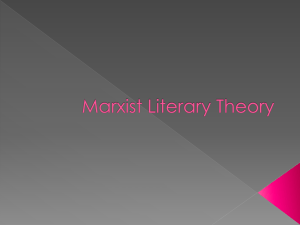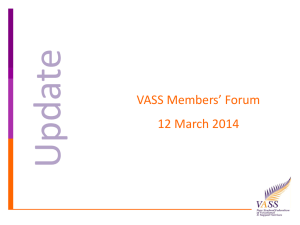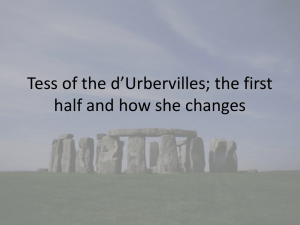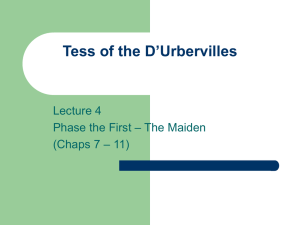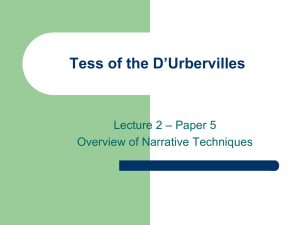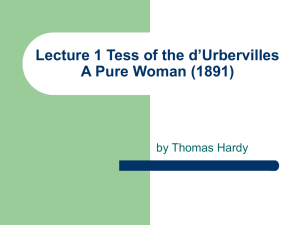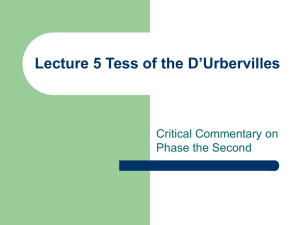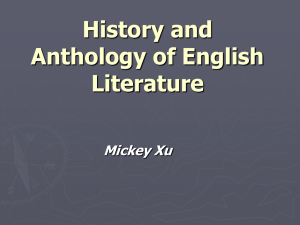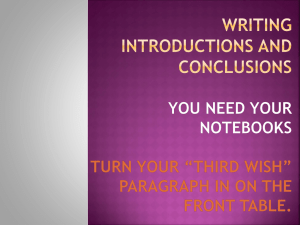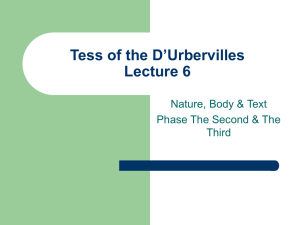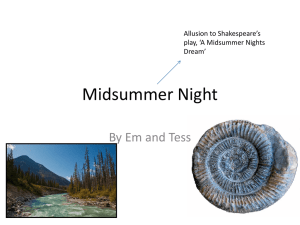Tess of the D`Urbervilles
advertisement
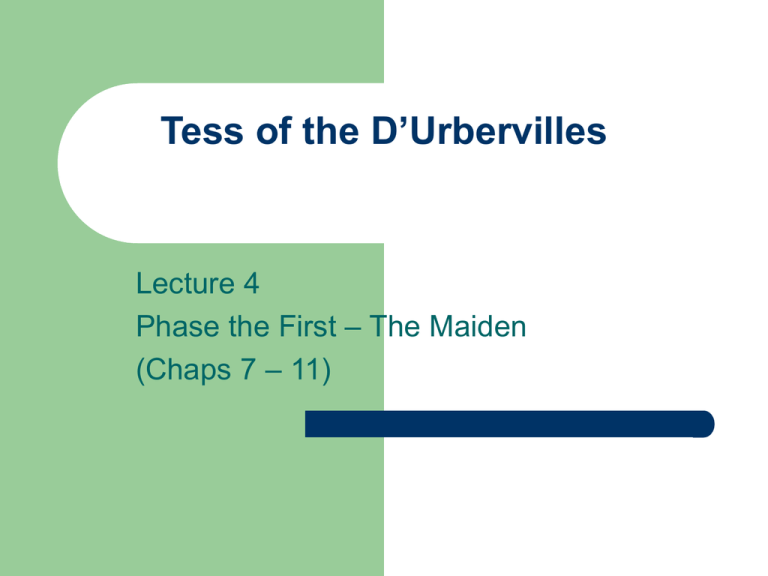
Tess of the D’Urbervilles Lecture 4 Phase the First – The Maiden (Chaps 7 – 11) Lawrence on Relationships The great relationship of humanity will always be— the relation between man and woman. The relation between man and man, woman and woman, parent and child, will always be subsidiary. – DH Lawrence Nature of Relationships Exploitative; Sexually exploitative Master-Slave relationships; Means-end Harmonious relationships; Oppressive… Relationships based on Love; and Lust Mutual Respect & Admiration; Unconditional Primacy: glory and power over others Human affairs all about winning and losing Key factors affecting Relationships Defined by position, career, wealth, and power Gender; Class (social status); ethnicity (e.g. Norman ancestry) Role of Religion & Culture in defining relationships; Accent and Speech; Standard English; Dialect Dwelling: cottage; Clothing e.g. ‘ladder-like holes…’ Mode of Transport: Gig; Cart; Carriage Looking down; Talking down, Talking to; Gesture (bowing, e.g. ‘She bowed to him slightly.’ ) Degree of Respect To what extent can Tess’s plight be attributed to the following factors? Methods of showing this? Contingent factors leading to Tess’s downfall: - Gender relations: male-female; female-female - Tess’s Character and Personality - Accident, Mishap, Coincidence / Fate Literary methods - Diction, Syntax, Use of Dialogue, Use of Dialect; Allusion; Use of Ballads, Imagery, Symbolism - Use of Setting; Setting as Symbolism - Narrative voice (also tone), and point of view Gender and Class (rustic country girl) Angel and Alec; John and Joan Durbeyfield, and the Trantridge women ‘construct’ Tess in particular ways that entrap her in stereotypical roles as defined by an intersection of class, and gender perceptions, and expectations. Hardy shows these different gender and class constructions through the use of shifting narrative perspectives (mediated by the use of a third person omniscient narrator) ‘Good-bye, my maid’, said Sir John, raising his head… [Chapter 7] Tone? Note the gently contemptuous humour of narrator’s parting reference to her father as ‘Sir John’ (Intended) Effect? Reminds us that Tess is a scapegoat for father’s sins His sleep-inspired recognition that he is saying ‘Goodbye’ to his ‘maid’ symbolically suggests the sacrifice to which she will be called on that account Male-female relations Alec and Angel arrive at contrasting interpretations of Tess’s personality, in response to the image of her in the white muslin dress she wears at the May-Day dance Angel’s viewpoint: Tess is ‘a white shape’ among a troop of ‘country hoydens’, albeit a ‘pretty maiden’ who is ‘modest’, ‘expressive, ‘soft’ ie. Woman as Madonna (Ch 2, p.18) Angel’s silent acceptance of his brothers’ judgement (‘dancing in public with a troop of country hoydens’) makes his first encounter with Tess a non-encounter, because he is unable at that point to see Tess as anything more than a common country girl to be dismissed from his mind. Male-female relations Alec’s point of view: Sees Tess as just a ‘farm girl’ whose position as ‘poor relation’ can be used to obtain / force her sexual surrender without the necessity for love or marriage Alec sees Tess as an object of male sexual desire, using stereotypical symbols like strawberries and roses (Ch 5) Alec typecasts Tess based on his understanding of the sexual ethics of her class – assumes her sexual availability based on her peasant status. “You are mighty sensitive for a cottage girl!” (Ch 8, p.56) Male-female relations The relationship between Tess and Alec involves an unequal balance of power that is rooted in social class, economic standing, and gender differences Alec – characterized as a stock villain (‘the moustachioed seducer of Victorian melodrama’) ‘an almost swarthy complexion, with full lips, badly moulded, though red and smooth… a well-groomed black moustache with curled points… touches of barbarism in his contours… singular force… bold rolling eye’ (Ch 5, p.40) Hardy illuminates the seductive power of Alec’s appearance and personality As Alec ‘nipped his cigar with the tips of his large white centre-teeth, and allowed his lips to smile slowly of themselves The narrator draws attention to the sexual motivation underlying the words from those lips Male-female relations Alec often presented on horseback or driving a carriage / cart – Actions symbolically suggestive of his position of power which he uses to exploit, dominate and control Tess. Eg. the dog-cart ride shows Alec’s mastery of the mare - “If any living man can manage this horse I can”; ‘…it was evident that the horse, whether of her own will or of his (the latter being the more likely) knew so well the reckless performance expected of her that she hardly required a hint from behind.’ (Ch 8, p.54) [Compare with Gerald’s taming of his red Arab mare in Ch 9 Coal-Dust, of Lawrence’s Women in Love] Eg. The horseride through The Chase immediately before the rape / seduction scene, Alec’s literal manipulation of their route mirrors his manipulation and emotional blackmail of Tess Male-female relations Hardy shows how patriarchal power is asserted in various ways – linguistically, economically, sexually. Linguistically – seen in the way Alec assigns her different names which define her identity and her relationship with him ‘Well my Beauty’ (Ch 5), ‘my pretty girl,’ ‘my pretty Coz’, ‘Durbeyfield only, you know – quite another name’, ‘You artful hussy!’ (Chapter 8) ‘Miss Independence’ (Ch 10) Note use of the possessive pronoun, ‘My’ Male-female relations Economically – Alec uses his position as Tess’s employer to get close to her; tries to ‘buy’ her affection with gifts for her family. ‘It was in the economy of this regime that Tess Durbeyfield had undertaken to fill a place… A familiarity with Alec D’Urberville’s presence – which the young man carefully cultivated… But she was more pliable under his hands than a mere companionship would have made her, owing to her unavoidable dependence upon his mother, and, through that lady’s comparative helplessness, upon him.’ (Ch 9, p.62) Male-female relations Sexually – Hardy builds up the narrative tension through the progressive escalation of Alec’s sexual advances. Notice Tess’s resistance becomes gradually more muted – from her spirited, strategic resistance during the first journey to Trantridge, to her silences during the horse ride through ‘The Chase’. ‘He was inexorable, and she sat still, and D’Urberville gave her the kiss of mastery.’ (Ch 8, p.56) Notice the effect? of sentence structure (use of parallel clauses) [Intended] Effect: Highlights and emphasizes the contrast between Alec’s sexual mastery, and Tess’s sexual passivity. Sentence Shape and Structure; Parallelism and Antithesis He was inexorable, and she sat still, and D’Urberville gave her the kiss of mastery. Male-female relations Use of animal imagery Symbolic significance of the caged bullfinches (Chapter 9) Ironically, like the bullfinches, Tess is trapped by her situation, even during the times when it appears that her captors are looking out for her welfare Compare and contrast this with the images of the caged hawk in WL – bullfinches can be tamed and managed, while hawks are untameable birds of prey Lawrence’s Women in Love ‘And all the while, his wife had opposed him like one of the great demons of hell. Strange, like a bird of prey, with the fascinating beauty and abstraction of a hawk, she had beat against the bars of his philanthropy, and like a hawk in cage, she had sunk into silence.’ [Chapter 17 The Industrial Magnate] Male-female relations Symbolic significance of the ‘community of fowls’ with which Tess is entrusted? (Ch 9, p.58) [Intended] Symbolic Effects? Domestication of these hens and cocks imagistically mirrors her domestication that Tess gradually undergoes under Alec’s careful cultivation and manipulation of her acquaintance Female-female relations Social reproduction of gender roles in the motherdaughter relationship “… she ought to make her way with ‘en, if she plays her trump card aright. And if he don’t marry her afore he will after. For that he’s all afire wi’ love for her any eye can see.” [Notice accent and dialect] “What’s her trump card? Her D’Urberville blood…?” “No, stupid; her face – as ‘twas mine.” (Ch 7, p.53) Enacted when Mrs D dresses up Tess in a way that ‘might cause her to be estimated as a woman when she was not much more than a child’ (Ch 7, p.49) Female-female relations Sexual rivalry that contributes to Tess’s fall Imagery of war. Effect? Suggests a power struggle between Tess and the other women No genuine female solidarity – ‘united… against the common enemy’ (ie Tess), and the men’s attempt to ‘make peace’ only serves ‘directly to increase the war.’ (Ch 10, p.67) Tess’s decision to accept Alec’s help is partly motivated by ‘fear and indignation at these adversaries’ that she knows ‘could be transformed… into a triumph over them’ (Ch. 10, p.68) Coincidence / fate Prince’s death symbolically functions as an ominous foreshadowing of a) the Chase seduction scene b) Tess’s murder of Alec c) The destruction of nature Parallels in plot patterns, imagery / symbolism Parallels suggest that events are caused by ‘fate’, but the actual plot mechanics are largely driven by coincidence The Chase scene and Ambivalence The ‘central ambivalence’ in the novel (Kristin Brady) The novel raises enormous implications concerning the question of Tess’s “purity” and Tess’s culpability The Chase Seduction Scene A continuation and intensification of the relationship dynamic established at their first meeting: a mixture of resistance and passivity Note: Tess’s silences (eg. p. 69: ‘She did not reply’, ‘She was silent’) creating what effect? An effect of ambiguity In contrast: Alec’s active manipulation of the situation – prolonging the horseride, telling her about his gifts to her family, the ‘well-known cordial’ The Chase Seduction Scene [Tess] ‘still panting in her triumph, yet in other respects dubious’ (Ch 11, p.69) ‘between archness and real dismay’ (Ch 11, p.71) Effect of ambivalence in Tess’s response ‘She passively sat down amid the leaves he had heaped’; ‘He touched her with his fingers, which which sank into her as into down’ (Ch 11, p.72) [Intended] Effect? Tess’s apparent docility and receptivity is suggested in the imagery and descriptive verbal language. The Chase scene Use of setting as symbolism The Chase: Symbolically represents a pagan past in which conventional codes of morality do not apply The darkness and silence of The Chase mirrors the narrative silence about what really happens Also the fog literally, and symbolically obscures events; thus creating what Effect? creates a sense of ambiguity The Chase seduction scene; Intrusive narrator’s commentary Defends Tess – Victim of unforeseen circumstances (eg. p.70: ‘She was inexpressibly weary….’) Narrator’s insistent rhetorical questions; Effect? Strongly suggestive of Tess’s innocence Alternative scenarios projected – accentuate the sense of waste, and what could have been Narrator’s intrusive closing comments impose an interpretation of Tess’s victimhood on the reader Tess is undone by unjust patriarchal prejudices regarding female sexuality;
